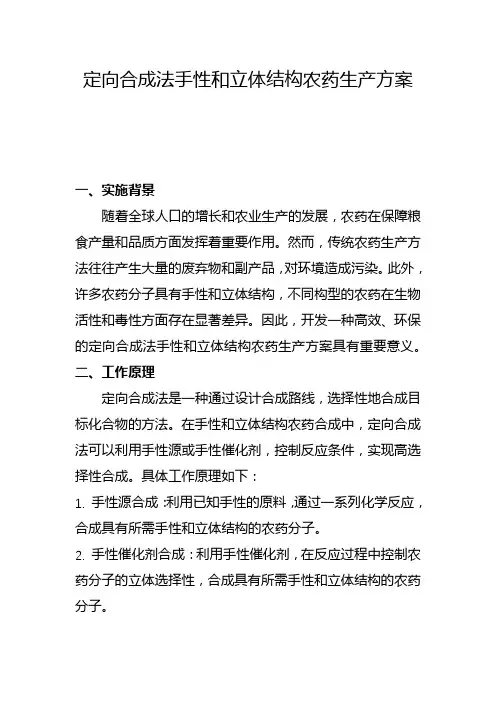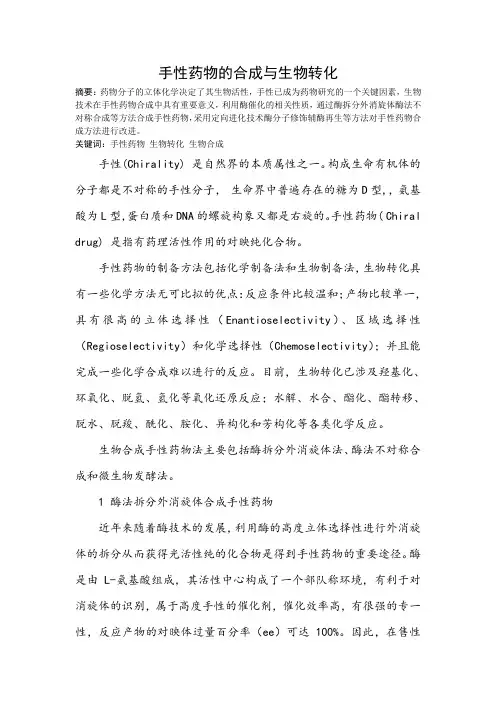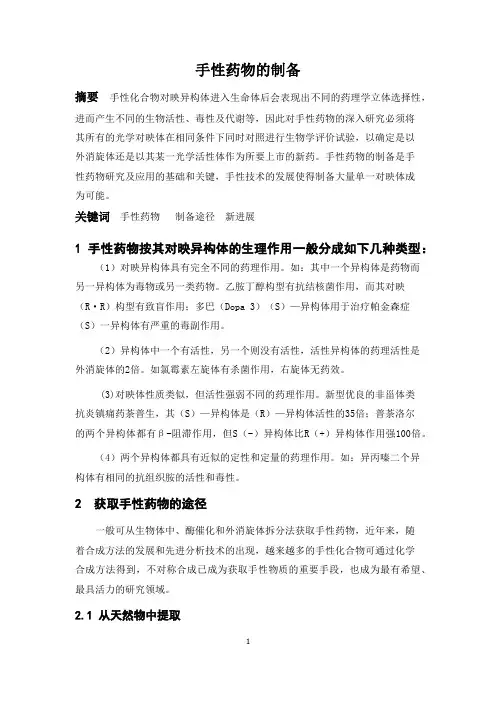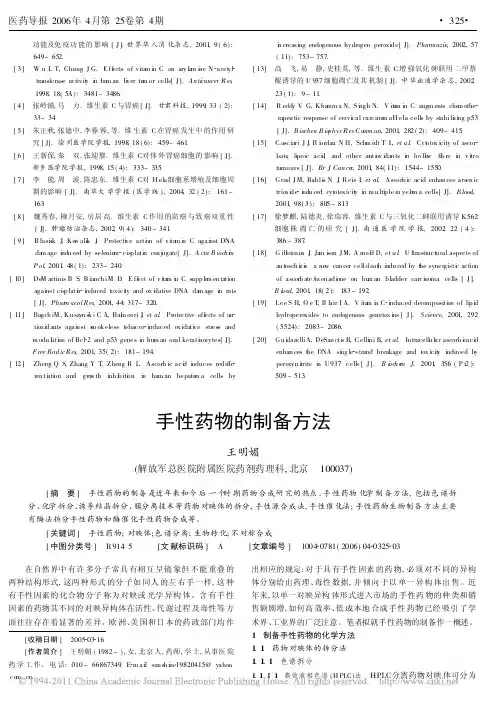第十六章 手性农药的合成
- 格式:ppt
- 大小:243.50 KB
- 文档页数:15


手性合成的综述姓名:学号:专业:院系:目录手性合成的概念与简介 (2)手性药物的合成的发展历程 (3)手性合成的方法 (5)几种手性药物合成方法的比较 (7)化学—酶合成法合成手性药物的实例 (7)手性药物的研究现状和展望 (10)参考资料 (13)手性药物的概念与简介手性(英文名为chirality, 源自希腊文cheir)是用来表达化合物分子结构不对称性的术语。
人的手是不对称的,左手和右手相互不能叠合,彼此是实物和镜像的关系,这种关系在化学中称为“对映关系”,具有对映关系的两个物体互为“对映体”。
化合物的手性与其空间结构有关,因为化合物分子中的原子的排列是三维的。
例如,图1中表示乳酸分子的结构式1 a和1 b,虽然连接在中心碳原子上的4个基团,即H, COOH, OH和CH3都一样,但它们却是不同的化合物。
它们之间的关系如同右手和左手之间的关系一样,互为对映体。
手性是人类赖以生存的自然界的本质属性之一。
生命现象中的化学过程都是在高度不对称的环境中进行的。
构成机体的物质大多具有一定空间构型,如组成蛋白质和酶的氨基酸为L-构型,糖为D-构型,DNA的螺旋结构为右旋。
在机体的代谢和调控过程中所涉及的物质(如酶和细胞表面的受体)一般也都具有手性,在生命过程中发生的各种生物-化学反应过程均与手性的识别和变化有关。
由自然界的手性属性联系到化合物的手性,也就产生了药物的手性问题。
手性药物是指药物的分子结构中存在手性因素,而且由具有药理活性的手性化合物组成的药物,其中只含有效对映体或者以有效的对映体为主。
这些对映异构体的理化性质基本相似,仅仅是旋光性有所差别,分别被命名为R-型(右旋)或S-型(左旋)、外消旋。
药物的药理作用是通过与体内的大分子之间严格的手性识别和匹配而实现的。
手性制药是医药行业的前沿领域,2001年诺贝尔化学奖就授予分子手性催化的主要贡献者。
自然界里有很多手性化合物,这些手性化合物具有两个对映异构体。

定向合成法手性和立体结构农药生产方案一、实施背景随着全球人口的增长和农业生产的发展,农药在保障粮食产量和品质方面发挥着重要作用。
然而,传统农药生产方法往往产生大量的废弃物和副产品,对环境造成污染。
此外,许多农药分子具有手性和立体结构,不同构型的农药在生物活性和毒性方面存在显著差异。
因此,开发一种高效、环保的定向合成法手性和立体结构农药生产方案具有重要意义。
二、工作原理定向合成法是一种通过设计合成路线,选择性地合成目标化合物的方法。
在手性和立体结构农药合成中,定向合成法可以利用手性源或手性催化剂,控制反应条件,实现高选择性合成。
具体工作原理如下:1. 手性源合成:利用已知手性的原料,通过一系列化学反应,合成具有所需手性和立体结构的农药分子。
2. 手性催化剂合成:利用手性催化剂,在反应过程中控制农药分子的立体选择性,合成具有所需手性和立体结构的农药分子。
三、实施计划步骤1. 目标农药分子的确定:根据市场需求和农业生产需要,确定需要合成的目标农药分子。
2. 合成路线的设计:根据目标农药分子的结构和性质,设计合理的合成路线,包括选择适当的手性源或手性催化剂。
3. 实验条件的优化:通过实验,优化反应条件,如温度、压力、反应时间等,实现高选择性合成。
4. 中试生产:在实验室研究基础上,进行中试生产,验证生产工艺的可行性和经济性。
5. 工业化生产:在中试生产成功后,进行工业化生产,实现定向合成法手性和立体结构农药的规模化生产。
四、适用范围本方案适用于需要合成具有手性和立体结构的农药分子,特别是那些在传统合成方法中难以获得高纯度单一异构体的农药分子。
例如,除草剂、杀虫剂、杀菌剂等。
五、创新要点1. 定向合成法的应用:采用定向合成法,可以选择性地合成具有所需手性和立体结构的农药分子,提高产品的质量和纯度。
2. 手性源和手性催化剂的选择:根据目标农药分子的结构和性质,选择适当的手性源或手性催化剂,实现高选择性合成。





Chiral Separation Techniques:A Practical Approach,Second,completely revised and updated editionEdited by G. SubramanianCopyright ©2001 Wiley-VCH Verlag GmbHISBNs:3-527-29875-4 (Hardcover); 3-527-60036-1 (Electronic) 3Combinatorial Approaches to Recognition of Chirality:Preparation and Use of Materials for theSeparation of EnantiomersFrantis˘ek S˘vec,Dirk Wulff and Jean M. J. Fréchet3.1IntroductionThe continuing trend to replace racemic drugs,agrochemicals,flavors,fragrances, food additives,pheromones,and some other products with their single enantiomers is driven by their increased efficiency,economic incentive to avoid the waste of the inactive enantiomer,and regulatory action resulting from the awareness that indi-vidual enantiomers have different interactions with biological systems. There are several methods to obtain enantiomerically pure compounds. The most important are:(i) syntheses based on chiral starting materials from natural sources such as amino acids; (ii) enantioselective reactions; and (iii) separations of mixtures of enan-tiomers using methods such as crystallization via diastereoisomers,enzymatic or chemical kinetic resolution,and chromatographic separation [1–3].Although very efficient,the broad application of the direct preparation is restricted due to the limited number of pure starting enantiomers. The design of a multistep process that includes asymmetric synthesis is cumbersome and the devel-opment costs may be quite high. This approach is likely best suited for the multi-ton scale production of “commodity”enantiomers such as the drugs ibuprofen, naproxen,atenolol,and albuterol. However,even the best asymmetric syntheses do not lead to products in an enantiomerically pure state (100%enantiomeric excess). Typically,the product is enriched to a certain degree with one enantiomer. Therefore, an additional purification step may be needed to achieve the required enantiopurity.The chromatographic methods that include gas and liquid chromatography,as well as electrophoresis fit into the third group of methods designed for the separa-tion of individual enantiomers from their mixtures. These techniques,characterized by the use of chiral stationary phases (CSP) and chiral additives,respectively, emerged more than three decades ago as valuable methods for analytical assays in academic laboratories and clinical testing. Since chromatography can be used in vir-tually any scale,it has also been used for preparative- and production-scale separa-tions due to its high efficiency and ease of operation. For example,preparative liq-uid chromatography implemented in the simulated moving bed (SMB) format enables the isolation of sufficient quantities of pure chiral compounds to carry out early pharmacological and toxicological studies providing both enantiomers forcomparative biological testing [4]. Chromatographic separations continue to be used for the process and quality controls,even after a large-scale asymmetric technology had been developed and implemented.3.2Engineering of a Chiral Separation MediumA chiral separation medium is a complex system. Ideally,interactions that lead to enantioseparation are maximized while nonspecific interactions should be com-pletely suppressed. Typically,a medium for chromatographic separations involves the solid support,the selector,and the linker connecting the two,as shown in scheme 3-1.Scheme 3-1Most commercial CSPs contain chiral selectors (vide infra) supported by porous silica beads. Silica-based chromatographic supports have numerous advantages such as broad range of different porosities,high mechanical stability,and resistance to swelling. Columns packed with these materials generally exhibit high efficiencies.However,residual silanol groups on the surface of the silica may contribute to non-specific interactions with the separated enantiomers,thereby decreasing the overall selectivity of the separation medium. This was demonstrated by the improved enan-tioselectivities measured for CSPs that had their residual silanol groups capped after the attachment of a chiral selector [5]. In contrast to silica particles,synthetic organic polymers are more seldom used as a platform for the preparation of chiral stationary phases. Their excellent stability over the entire range of pH,the variety of available chemistries,and the more accurate control of both the functionality and the porous properties make them a good alternative to the well-established silica matrices.Although porous polymer beads have been used successfully for a wide variety of chromatographic separations including the size-exclusion chromatography of synthetic polymers,the normal-phase or reversed-phase separations of small molecules,and the ion-exchange and hydrophobic interaction chromatography of biopolymers,there are only a few examples of polymer-based chiral separation media with attached selectors [6–10]. In contrast,a larger number of chiral separa-tions has been demonstrated using polymer-based molecular imprinted separation media [5,11–13].The use of a polymeric support also affords a unique opportunity to control inde-pendently the variables that may affect the chiral recognition process,which is hard to achieve with silica. For example,the type and number of reactive sites can be eas-ily adjusted with a polymer support. We recently reported an extensive study of the563Combinatorial Approaches to Recognition of Chirality:Preparation …effects of support chemistry,surface polarity,length and polarity of the tether,and selector loading [14]. Our group also demonstrated that separation media based on an organic polymer support provide enhanced enantioselectivities and reduced reten-tion times when compared to analogous silica-based chiral stationary phases,mostly as a result of substantially decreased nonspecific interactions (Fig. 3-1) [8].Fig. 3-1.Separation of racemic 3,5-dinitrobenzamido leucine N,N -diallylamide on silica and polymer-based chiral stationary phases. Conditions:column size 150 ×4.6 mm i.d.; mobile phase 20%hexane in dichloromethane; flowrate 1 mL min –1; injection 7 µg. Peaks shown are:1,3,5-tri-tert.-butylbenzene(1),R-enantiomer (2); S -enantiomer (2Ј). (Reprinted with permission from ref. [8]. Copyright 1997American Chemical Society.)3.3Chiral SelectorsEnantioseparation is typically achieved as a result of the differences in interaction energies ∆(∆G) between each enantiomer and a selector . This difference does not need to be very large,a modest ∆(∆G) = 0.24 kcal/mol is sufficient to achieve a sep-aration factor αof 1.5. Another mechanism of discrimination of enantiomers involves the preferential inclusion of one into a “cavity”or within the helical struc-ture of a polymer. The selectivity of a selector is most often expressed in terms of retention of both enantiomers using the separation factor αthat is defined as:α= k Ј2/k Ј1(1)where k Ј1and k Ј2are the retention factors of the first and the second peak,respec-tively,defined ask Ј= (t r – t o )/t o (2)3.3Chiral Selectors 57where tr and toare the retention times for the analyte and the unretained compound(void volume marker),respectively.Chiral selectors are the most important part of the separation system. This is why most attention during the development of new chiral separation media has always been devoted to selectors. As a result of the growing interest in chiral chromatogra-phy,a large number of phases and additives have emerged to meet the challenge of enantiomer separations [5,15,16]. For example,more than 90 CSPs were commer-cially available for separations in the liquid chromatographic mode in the early 1990s [17].The majority of currently known selectors can be divided into the following cat-egories:1.Proteins.A chiral stationary phase with immobilized α1-acid glycoprotein on sil-ica beads was introduced by Hermansson in 1983 [18,19]. Several other proteins such as chicken egg albumin (ovalbumin),human serum albumin,and cellohy-drolase were also used later for the preparation of commercial CSPs. Their selec-tivity is believed to occur as a result of excess of dispersive forces acting on the more retained enantiomer [17]. These separation media often exhibit only modest loading capacity.2.M odified polysaccharides.Although derivatives of microcrystalline cellulosehave been used for chiral separations since the 1970s [20],materials useful in high-performance liquid chromatography (HPLC) were only developed by Okamoto in the mid-1980s. CSPs involving various esters and carbamates of cel-lulose and amylose coated on wide-pore silica are currently the most frequently used chiral media for chromatographic separations in both analytical and prepar-ative scales [21,22]. Although they often do not exhibit very high selectivities, they separate an extremely broad range of different racemates.3.Synthetic polymers.In the 1970s,Blaschke prepared several crosslinked gels fromN-acryloylated L-amino acids and a small percentage of ethylene dimethacrylate or divinylbenzene and used them for the low-pressure chromatographic resolution of racemic amino acid derivatives and mandelic acid [23]. Another polymer-based CSP was later prepared by Okamoto from isotactic poly(triphenylmethyl methacrylate). This material is the prototypical polymeric selector with a well-defined one-handed helical structure [24]. This polymer was prepared by anionic polymerization using a chiral organolithium initiator,and then coated onto porous silica beads. While these columns were successful in the separation of a broad variety of racemates,their relative lack of chemical stability and high cost make them less suitable for large-scale applications.4.Macrocyclic glycopeptides. The first of these CSPs – based on the “cavity”of theantibiotic vancomycin bound to silica – was introduced by Armstrong [25]. Two more polycyclic antibiotics teicoplanin and ristocetin A,were also demonstrated later. These selectors are quite rugged and operate adequately in both normal-phase and reversed-phase chromatographic modes. However,only a limited num-ber of such selectors is available,and their cost is rather high.5.Cyclic low molecular weight compounds. Chiral separations using chiral crownethers immobilized on silica or porous polymer resins were first reported in the 583Combinatorial Approaches to Recognition of Chirality:Preparation …3.3Chiral Selectors59mid-1970s [6]. These highly selective and stable selectors have found only a lim-ited application for the separation of atropoisomers. In contrast,modified cyclic glucose oligomers – cyclodextrins – have proven to be very universal chiral selec-tors for chiral separations in electrophoresis,gas chromatography,and liquid chromatography [26]. In addition to the formation of reversible stereoselective inclusion complexes with the hydrophobic moieties of the solute molecules that fit well into their cavity,they are often functionalized to further enhance hydro-gen bonding and dipolar interactions [27]. Attached covalently to porous silica beads,they afford very robust CSPs with modest selectivities for a number of racemates.6.M etal ion complexes.These “classic”CSPs were developed independently byDavankov and Bernauer in the late 1960s. In a typical implementation,copper (II) is complexed with L-proline moieties bound to the surface of a porous polymer support such as a Merrifield resin [28–30]. They only separate well a limited num-ber of racemates such as amino acids,amino alcohols,and hydroxyacids.7.Small chiral molecules. These CSPs were introduced by Pirkle about two decadesago [31,32]. The original “brush”-phases included selectors that contained a chi-ral amino acid moiety carrying aromatic π-electron acceptor or π-electron donor functionality attached to porous silica beads. In addition to the amino acids,a large variety of other chiral scaffolds such as 1,2-disubstituted cyclohexanes [33] and cinchona alkaloids [34] have also been used for the preparation of various brush CSPs.3.3.1Design of New Chiral SelectorsCSPs with optically active polymers,such as modified cellulose,polyacrylates,and proteins,have been used successfully for a variety of enantioseparations [5,13,15, 17]. Despite extended studies,the mechanism of separation for these CSPs is not yet completely understood,which makes it difficult to develop new media of this type. In contrast,bonded natural and synthetic chiral selectors such as substituted cyclodextrins,crown ethers,and brush-type selectors have several advantages including well-defined molecular structures and sufficiently developed enantiomer “recognition”models. For example,the separation of enantiomers with brush-type stationary phases is based on the formation of diastereoisomeric adsorbate “com-plexes”between the analyte and the selector. According to the Dalgliesh’s 3-point model [35],enantiomer recognition is achieved as a result of three simultaneous attractive interactions (donor–acceptor interactions such as hydrogen bonding,π-stacking,dipole–dipole interactions,etc.) between the selector and one of the enan-tiomers being separated. At least one of these interactions must be stereochemically dependent [36–39]. Compared to all other selectors,brush-type systems afford the most flexibility for the planned development of a variety of different chiral station-ary phases suitable for the separation of a broad range of analyte types [40,41].The majority of the original chiral selectors for brush-type CSPs were derived from natural chiral compounds. Selectors prepared from amino acids,such as phenyl603Combinatorial Approaches to Recognition of Chirality:Preparation …3.5Acceleration of the Discovery Process61 their ultimate length is limited by the overall pressure drop that can be tolerated by the system. SMB technology helps to solve both these difficulties [50].A better solution for preparative columns is the development of separation media with substantially increased selectivities. This approach allows the use of shorter columns with smaller number of theoretical plates. Ultimately,it may even lead to a batch process in which one enantiomer is adsorbed selectively by the sorbent while the other remains in the solution and can be removed by filtration (single plate sep-aration). Higher selectivities also allow overloading of the column. Therefore,much larger quantities of racemic mixtures can be separated in a single run,thus increas-ing the throughput of the separation unit. Operation under these “overload”condi-tions would not be possible on low selectivity columns without total loss of resolu-tion.Another important issue that must be considered in the development of CSPs for preparative separations is the solubility of enantiomers in the mobile phase. For example,the mixtures of hexane and polar solvents such as tetrahydrofuran,ethyl acetate,and 2-propanol typically used for normal-phase HPLC may not dissolve enough compound to overload the column. Since the selectivity of chiral recognition is strongly mobile phase-dependent,the development and optimization of the selec-tor must be carried out in such a solvent that is well suited for the analytes. In con-trast to analytical separations,separations on process scale do not require selectivity for a broad variety of racemates,since the unit often separates only a unique mixture of enantiomers. Therefore,a very high key-and-lock type selectivity,well known in the recognition of biosystems,would be most advantageous for the separation of a specific pair of enantiomers in large-scale production.Despite continuing progress in the design of new selectors,the process is slow as it mostly involves a traditional one-selector/one-column-at-a-time methodology. 3.5Acceleration of the Discovery Process3.5.1Reciprocal ApproachThe first approach to the accelerated development of chiral selectors reported by Pirkle’s group in the late 1970s relied on the “principle of reciprocity”[51]. This is based on the concept that if a molecule of a chiral selector has different affinities for the enantiomers of another substance,then a single enantiomer of the latter will have different affinities for the enantiomers of the identical selector. In practice,a separa-tion medium is prepared first by attaching a single enantiomer of the target com-pound to a solid support that is subsequently packed into a HPLC column. Race-mates of potential selectors are screened through this column to identify those that are best separated. The most promising candidate is then prepared in enantiopure form and attached to a support to afford a CSP for the separation of the target race-mate. This simple technique was used by several groups for the screening of various623Combinatorial Approaches to Recognition of Chirality:Preparation …families of compounds [52–55] The reciprocal method is particularly suitable for sit-uations in which the target enantiomer is known and its separation from a racemate is required. Since chromatographic techniques are readily automated,a broad vari-ety of novel chiral ligands may be considered.3.5.2Combinatorial ChemistryAlthough the reciprocal approach potentially enables the screening of large numbers of compounds,only the advent of combinatorial chemistry brought about the tools required for the synthesis of large libraries of potential selectors in a very short period of time. In addition,using the methods of combinatorial chemistry,novel strategies different from those of the reciprocal approach could also be developed.Combinatorial chemistry and high-throughput parallel synthesis are powerful tools for the rapid preparation of large numbers of different compounds with numer-ous applications in the development of new drugs and drug candidates [56–58], metal-complexing ligands and catalysts [59–63],polymers [64],materials for elec-tronics [65,66],sensors [67],supramolecular assemblies [68–70],and peptidic li-gands for affinity chromatography [71]. The essence of combinatorial synthesis is the ability to generate and screen or assay a large number of chemical compounds –a “library”– very quickly. Such an approach provides the diversity needed for the discovery of lead compounds and,in addition,allows their prompt optimization. The fundamentals of combinatorial chemistry,including rapid screening methodologies, are reviewed in numerous papers and books [72,73]. The following sections of this chapter will describe a variety of different combinatorial methods that have led to selectors for the recognition of chirality aiming mainly at the development of robust media for the separation of enantiomers.3.6Library of Cyclic Oligopeptides as Additives to Back-ground Electrolyte for Chiral Capillary ElectrophoresisEnantioresolution in capillary electrophoresis (CE) is typically achieved with the help of chiral additives dissolved in the background electrolyte. A number of low as well as high molecular weight compounds such as proteins,antibiotics,crown ethers,and cyclodextrins have already been tested and optimized. Since the mecha-nism of retention and resolution remains ambiguous,the selection of an additive best suited for the specific separation relies on the one-at-a-time testing of each individ-ual compound,a tedious process at best. Obviously,the use of a mixed library of chi-ral additives combined with an efficient deconvolution strategy has the potential to accelerate this selection.The power of a combinatorial approach to chiral additives for CE was firstdemonstrated by Jung and Schurig who used a library of cyclic hexapeptides [74].Since the number of hexapeptides representing all possible combinations of 20 nat-ural L -amino acids is 64 ×106,the first study involved only mixed libraries of hexapeptides of the type c(OOXXXO) consisting of three fixed positions O and three randomized positions X represented by any of 18 natural amino acids (cys-teine and tryptophan were not included into the scheme). Three cyclopeptide libraries c(L-Asp-L-Phe-XXX-D-Ala),c(L-Arg-L-Lys-XXX-D-Ala),and c(L-Arg-L-Met-XXX-D-Ala),each consisting of 5832 members,were prepared and tested in chiral CE. When dissolved in an electrolyte to form 10 mmol/L solutions,all three libraries enabled the separation of racemates. For example,the first library facilitated the baseline separation of racemic Tröger’s base in a 67 cm-long capillary with a selectivity factor αof 1.01 and column efficiency of 360000 plates. Similarly,the second library helped to resolve the N -2,4-dinitrophenyl (DNP) derivative of glu-tamic acid in a capillary with the same length affording a selectivity factor of 1.13and a column efficiency of 79000 plates. These results indicate the presence of use-ful selectors in the mixed library. However,this brief study did not attempt the deconvolution of the mixture and did not identify the best selector.Scheme 3-2.The deconvolution of a cyclic hexapeptide library to specify the best selector for the target racemate has recently been reported by Chiari et al. [75]. Several libraries of linear hexapeptides with protected lateral chains were prepared using solid-phase synthesis on Merrifield resin,and the cyclization reaction was carried out after cleavage in solution. The study also started with a mixed library of 5832 compounds consisting of cyclic c(OOXXXO) hexapetides with 3 fixed ”O“ positions consisting of L -arginine,L -lysine,and β-alanine and 3 randomized positions (X) occupied by any of the 18 L -amino acids (Scheme 3-2a). Once again,cysteine and tryptophan were not included. The substitution of D -alanine originally used by Jung and Schurig3.6Library of Cyclic Oligopeptides as Additives to Background Electrolyte (63)with β-alanine led to improved resolution of DNP-glutamic acid enantiomers achieved with the complete mixture.Since the proline residue in peptides facilitates the cyclization,3 sublibraries each containing 324 compounds were prepared with proline in each randomized position.Resolutions of 1.05 and 2.06 were observed for the CE separation of racemic DNP-glutamic acid using peptides with proline located on the first and second random position,while the peptide mixture with proline preceding the β-alamine residue did not exhibit any enantioselectivity. Since the c(Arg-Lys-O-Pro-O-β–Ala) library afforded the best separation,the next deconvolution was aimed at defining the best amino acid at position 3. A rigorous deconvolution process would have required the preparation of 18 libraries with each amino acid residue at this position.However,the use of a HPLC separation step enabled a remarkable acceleration of the deconvolution process. Instead of preparing all of the sublibraries,the c(Arg-Lys-O-Pro-O-β-Ala) library was fractionated on a semipreparative C 18HPLC column and three fractions as shown in Fig. 3-2 were collected and subjected to amino acid analysis. According to the analysis,the least hydrophobic fraction,which eluted first,did not contain peptides that included valine,methionine,isoleucine,leucine,tyrosine,and phenylalanine residues and also did not exhibit any separation ability for the tested racemic amino acid derivatives (Table 3-1).643Combinatorial Approaches to Recognition of Chirality:Preparation …fraction 1fraction 2fraction 3802501020304050Time (min)A b s o r b a n c e a t 226 n m (–)P e r c e n t a g e o f A c e t o n i t r i l e (- - - -)Fig. 3-2.Semipreparative RP-HPLC profile of cyclo(Arg-Lys-X-Pro-X-Ala). The crude sublibrary (160mol) was dissolved in 0.1% (v/v) TFA and applied to a Whatman Partisil 10 µm ODS-2 (1 ×50 cm)column. The peaks were eluted using a 40-min linear gradient of 0–25% acetonitrile in water at a flowrate of 7mL min –1. Fractions were collected every 2 min and pooled in three fractions as indicated by arrows; 130 µmol of peptides was recovered (yield 81%). (Reprinted with permission from ref. [75].Copyright 1998,American Chemical Society.)Fig. parison of the values of enantiomeric resolution of different DNP-D ,L -amino acids at dif-ferent deconvolution stages of a cyclic hexapeptide sublibrary. Resolution values in a cyclo(Arg-Lys-X-X-X-β-Ala) sublibrary,in the first line,are compared to those obtained in sublibraries with a progres-sively increasing number of defined positions. All the sublibraries were 30 m M in the running buffer while the completely defined cyclo(Arg-Lys-Tyr-P-Tyr-β–Ala) peptide is used at 10 m M concentration. Condi-tions:cyclopeptide sublibrary in 20 m M sodium phosphate buffer,pH 7.0; capillary,50 total length,57 cm to the window; V = –20 kV ,I = 40; electrokinetic injection,–10 kV ,3 s; detection at 340 nm. (Reprinted with permission from ref. [75]. Copyright 1998,American Chemical Society.)RKYPYßA RKYPXßA RKXPXßA RKXXXßAD N P -G l u R e s o l u t i o n D N P -A l aD N P -n -V a lD N P -h -S e r D N P -G l n D N P -L e uD N P -A s pD N P -P r o 302520151053.6Library of Cyclic Oligopeptides as Additives to Background Electrolyte (65)The improvements in resolution achieved in each deconvolution step are shown in Figure 3-3. While the initial library could only afford a modest separation of DNB-glutamic acid,the library with proline in position 4 also separated DNP derivatives of alanine and aspartic acid,and further improvement in both resolution and the number of separable racemates was observed for peptides with hydrophobic amino acid residues in position 3. However,the most dramatic improvement and best selec-tivity were found for c(Arg-Lys-Tyr-Pro-Tyr-β-Ala) (Scheme 3-2a) with the tyrosine residue at position 5 with a resolution factor as high as 28 observed for the separa-tion of DNP-glutamic acid enantiomers.In addition to the development of the powerful chiral additive,this study also demonstrated that the often tedious deconvolution process can be accelerated using HPLC separation. As a result,only 15 libraries had to be synthesized instead of 64libraries that would be required for the full-scale deconvolution. A somewhat simi-lar approach also involving HPLC fractionations has recently been demonstrated by Griffey for the deconvolution of libraries screened for biological activity [76].Although demonstrated only for CE,the cyclic hexapeptides might also be useful selectors for the preparation of chiral stationary phases for HPLC. However,this would require the development of non-trivial additional chemistry to appropriately link the peptide to a porous solid support.3.6.1Library of Chiral CyclophanesInspired by the separation ability of cyclic selectors such as cyclodextrins and crown ethers,Malouk’s group studied the synthesis of chiral cyclophanes and their interca-lation by cation exchange into a lamellar solid acid,α-zirconium phosphate aiming at the preparation of separation media based on solid inorganic-organic conjugates for simple single-plate batch enantioseparations [77–80].Scheme 3-3.663Combinatorial Approaches to Recognition of Chirality:Preparation …An example of the modular preparation of the cyclophane 3from the substituted bipyridine 2and a general tripeptide 1is shown in Scheme 3-3. The host molecule 3contains a pre-organized binding pocket. The overall basicity of such molecules also facilitates their intercalation within the lamellas of acidic zirconium phosphate,thus making this chemistry well suited for the desired application.While the bipyridinium part of the cycle is fixed,the peptidic module is amenable to combinatorial variation. The ability of a library of cyclophanes 3containing 20dipeptides and one tripeptide to recognize chiral compounds was studied in deu-terium oxide solutions using the facile 1H NMR titration technique that required only a small amount of the selector [77–79]. The chemical shifts of both protons of the –CH 2– group linking the bipyridinium unit with the phenyl groups of the cyclo-phane were monitored as a function of concentration of the added guest molecules (Fig. 3-4) and used to calculate of binding constants K.3.6Library of Cyclic Oligopeptides as Additives to Background Electrolyte (67)0.0200.0150.0100.0050.00000.1Concentration (M)0.25.8 5.7ppm 5.6(c)(b)(a)B.A.0.3S-DOPA ∆p p m R-DOPAFig. 3-4. (A) Changes in chemical shift of protons of cyclophane –CH 2– groups between bipyridinium and phenyl in 1H NMR spectra of 3as a function of (R)-DOPA concentration (a) 0,(b) 0.111,and (c)0.272 mol L –1. (B) Change in chemical shift plotted against the analytical concentration of (R )- and (S )-DOPA. The solid line is calculated for 1:1 host – guest complexation. (Reprinted with permission from ref. [79]. Copyright 1998,American Chemical Society.)。

手性药物的合成与生物转化摘要:药物分子的立体化学决定了其生物活性,手性已成为药物研究的一个关键因素,生物技术在手性药物合成中具有重要意义,利用酶催化的相关性质,通过酶拆分外消旋体酶法不对称合成等方法合成手性药物,采用定向进化技术酶分子修饰辅酶再生等方法对手性药物合成方法进行改进。
关键词:手性药物生物转化生物合成手性(Chirality) 是自然界的本质属性之一。
构成生命有机体的分子都是不对称的手性分子,生命界中普遍存在的糖为D型,,氨基酸为L型,蛋白质和DNA的螺旋构象又都是右旋的。
手性药物( Chiral drug) 是指有药理活性作用的对映纯化合物。
手性药物的制备方法包括化学制备法和生物制备法,生物转化具有一些化学方法无可比拟的优点:反应条件比较温和;产物比较单一,具有很高的立体选择性(Enantioselectivity)、区域选择性(Regioselectivity)和化学选择性(Chemoselectivity);并且能完成一些化学合成难以进行的反应。
目前,生物转化已涉及羟基化、环氧化、脱氢、氢化等氧化还原反应;水解、水合、酯化、酯转移、脱水、脱羧、酰化、胺化、异构化和芳构化等各类化学反应。
生物合成手性药物法主要包括酶拆分外消旋体法、酶法不对称合成和微生物发酵法。
1 酶法拆分外消旋体合成手性药物近年来随着酶技术的发展,利用酶的高度立体选择性进行外消旋体的拆分从而获得光活性纯的化合物是得到手性药物的重要途径。
酶是由L-氨基酸组成,其活性中心构成了一个部队称环境,有利于对消旋体的识别,属于高度手性的催化剂,催化效率高,有很强的专一性,反应产物的对映体过量百分率(ee)可达100%。
因此,在售性药物合成过程中,用酶拆分消旋体是理想的选择。
D-苯甘氨酸金额D-对羟基苯甘氨酸是生产半合成青霉素和头孢菌类抗生素的重要侧链。
DSM公司(Geleen,荷兰)利用恶臭假单胞菌(Pseydomonas putida)和L-氨肽酶拆分DL-氨基酸酰胺获得了D-苯甘氨酸和D-对羟基苯甘氨酸。

手性药物的制备摘要手性化合物对映异构体进入生命体后会表现出不同的药理学立体选择性,进而产生不同的生物活性、毒性及代谢等,因此对手性药物的深入研究必须将其所有的光学对映体在相同条件下同时对照进行生物学评价试验,以确定是以外消旋体还是以其某一光学活性体作为所要上市的新药。
手性药物的制备是手性药物研究及应用的基础和关键,手性技术的发展使得制备大量单一对映体成为可能。
关键词手性药物制备途径新进展1 手性药物按其对映异构体的生理作用一般分成如下几种类型:(1)对映异构体具有完全不同的药理作用。
如:其中一个异构体是药物而另一异构体为毒物或另一类药物。
乙胺丁醇构型有抗结核菌作用,而其对映(R·R)构型有致盲作用;多巴(Dopa 3)(S)—异构体用于治疗帕金森症(S)一异构体有严重的毒副作用。
(2)异构体中一个有活性,另一个则没有活性,活性异构体的药理活性是外消旋体的2倍。
如氯霉素左旋体有杀菌作用,右旋体无药效。
(3)对映体性质类似,但活性强弱不同的药理作用。
新型优良的非甾体类抗炎镇痛药荼普生,其(S)—异构体是(R)—异构体活性的35倍;普荼洛尔的两个异构体都有β-阻滞作用,但S(-)异构体比R(+)异构体作用强100倍。
(4)两个异构体都具有近似的定性和定量的药理作用。
如:异丙嗪二个异构体有相同的抗组织胺的活性和毒性。
2 获取手性药物的途径一般可从生物体中、酶催化和外消旋体拆分法获取手性药物,近年来,随着合成方法的发展和先进分析技术的出现,越来越多的手性化合物可通过化学合成方法得到,不对称合成已成为获取手性物质的重要手段,也成为最有希望、最具活力的研究领域。
2.1 从天然物中提取在某些生物体中含有具备生理活性的天然产物,可用适当的方法提取而得到手性化合物,某些手性药物是从动植物中提取的氨基酸、萜类化合物和生物碱。
如:具有极强抗癌活性的紫彬醇最初是从紫彬树树皮中发现和提取的,现已实现了不对称合成。

功能及免疫功能的影响[J].世界华人消化杂志,2001,9(6):649-652.[3] W u L T,Chung J G.E ff ects of vita m i n C on ary l a m i ne N acet yltransferas e activit y i n hu m an li ver tu m or cells[J].An ti cancer R es,1998,18(5A):3481-3486.[4] 张岭漪,马 力.维生素C与胃癌[J].甘肃科技,1999,33(2):33-34.[5] 朱正秋,张德中,李蓉蓉,等.维生素C在胃癌发生中的作用研究[J].徐州医学院学报,1998,18(6):459-461.[6] 王新保,秦 双,张迎黎.维生素C对体外胃癌细胞的影响[J].新乡医学院学报,1998,15(4):333-335.[7] 李 能,周 波,陈忠东.维生素C对H el a细胞系增殖及细胞周期的影响[J].南华大学学报(医学版),2004,32(2):161-163.[8] 魏秀春,柳月安,房居高.维生素C作用的防癌与致癌双重性[J].肿瘤防治杂志,2002,9(4):340-341.[9] B lasi ak J,Ko w ali k J.Protecti ve acti on of vita m i n C agai nst DNAda m age i ndu ced by seleniu m cis p lati n con j ugate[J].A cta B ioc h i mP ol,2001,48(1):233-240.[10] De M artinis B S,B ianch iM D.E ff ect of v i ta m i n C s upp l e m en tati onagai ns t cis p lati n i nduced t oxici ty and ox i dative DNA da m age i n rats[J].Phar m acolR es,2001,44:317-320.[11] Bagch iM,Ku sz yn s k i C A,Bal m oori J,et al.Protective eff ects of antioxi d ants agai n st s m ok el ess t obacco i nduced oxidati ve stres s andm odu l ati on of Bcl 2and p53genes i n hum an oral kerati nocytes[J].F ree Rad ic R es,2001,35(2):181-194.[12] Zheng Q S,Zhang Y T,Zheng R L.Ascorb ic aci d i nduces red ifferen ti ati on and gro w th i nh i b iti on i n hum an hepato m a cells byi n creas i ng endogenous hydrogen peroxi d e[J].Pharmazie,2002,57(11):753-757.[13] 高 飞,易 静,史桂英,等.维生素C增强氧化砷联用二甲萘醌诱导的U937细胞凋亡及其机制[J].中华血液学杂志,2002,23(1):9-11.[14] R eddy V G,Kha mm a N,S i ngh N.V it a m i n C augm ents che m otherapeu tic response of cervi cal carcino m aH ela cell s by st abili z i ng p53[J].B iochen B io phys R es C o mm un,2001,282(2):409-415. [15] C asciari J J,R i ordan N H,Schm idt T L,et a l.Cyt otox i city of ascorbate,li poic aci d,and other anti ox i dan ts i n ho ll o w fi b re i n v i trotumours[J].Br J Can ce r,2001,84(11):1544-1550.[16] Grad J M,Bah li s N J,Reis I,et al.Ascorb i c acid enhan ces ars en ictrioxi d e i ndu ced cyt otoxicit y i n m u lti p le m yel o m a cells[J].B lood,2001,98(3):805-813.[17] 徐梦麒,陆德炎,徐瑞容.维生素C与三氧化二砷联用诱导K562细胞株凋亡的研究[J].南通医学院学报,2002,22(4):386-387.[18] G ill oteaux J,Ja m i son J M,A rnol d D,e t a l.U ltrastruct u ral aspects ofau t osch i z i s:a ne w can cer celld eat h indu ced by t he synergisti c actionof ascorb ate/m en ad i one on hu m an b l adder carci noma cells[J].B l ood,2001,18(2):183-192.[19] Lee S H,O e T,B l air I A.V ita m i n C i nduced decompositi on of li p i dhydroperoxides to endogenous genotox i ns[J].S cience,2001,292(5524):2083-2086.[20] Gu i darelliA,DeSan cti s R,C elli n i B,e t al.In tracell u l ar ascorb i caci denhan ces t he DNA si ng l e s trand breakage and tox i cit y i nduced byperoxyn i trite i n U937cell s[J].B i oc h e m J,2001,356(P t2):509-513.手性药物的制备方法王明媚(解放军总医院附属医院药剂药理科,北京 100037)[摘 要] 手性药物的制备是近年来和今后一个时期药物合成研究的热点,手性药物化学制备方法,包括色谱拆分、化学拆分、诱导结晶拆分、膜分离技术等药物对映体的拆分,手性源合成法,手性催化法;手性药物生物制备方法主要有酶法拆分手性药物和酶催化手性药物合成等。